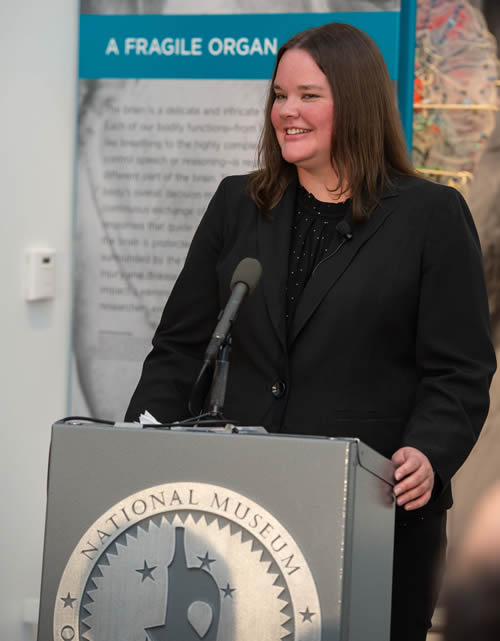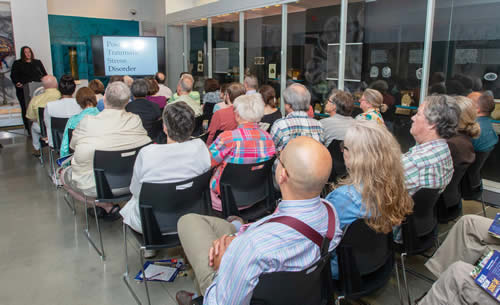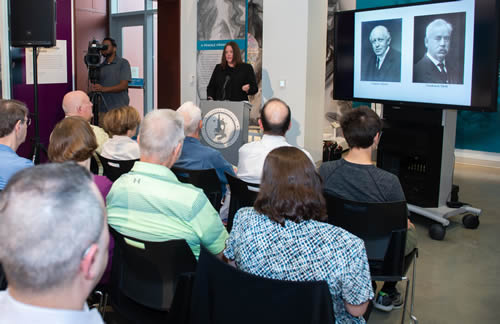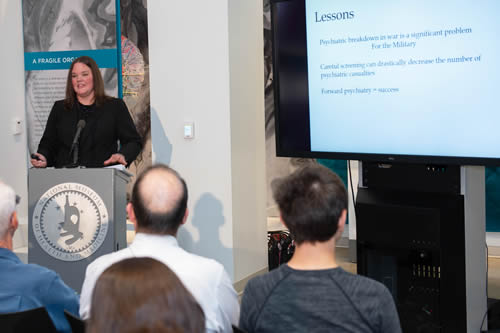"Shell Shock" Treatment During World War I: A First Step Towards Modern Military Psychiatry
By Lauren Bigge
NMHM Public Affairs Coordinator
During World War I, psychiatric care of soldiers received more attention than it had at any time in the past, Rachel Levandoski, historian from the Office of the Secretary of Defense Historical Office, told the Medical Museum Science Café audience at the National Museum of Health and Medicine (NMHM) on July 24. Levandoski's presentation on "shell shock" and a special exhibit, "PUT ON YOUR MASK, YOU DAMN FOOL!" at NMHM are part of the Department of Defense museum's centennial commemoration of World War I.
Prior to World War I, physicians observed warfighters having psychological breakdowns and called the condition "nostalgia." Physicians did not connect "nostalgia" to psychological trauma and war.
The physicians in World War I saw mental breakdowns at an unprecedented rate. "Because some of the early sufferers were also victims of severe artillery bombardments, soldiers and doctors started to label these symptoms as shell shock," Levandoski said.
By 1917 when Americans were fighting in World War I, most mental health professionals concluded that shell shock was a psychological condition because they saw a high number of shell shock cases – but those men had not been exposed to shelling. Some had never served on the front line.
The National Committee for Mental Hygiene sent Dr. Thomas Salmon, its medical director, to Britain and France in spring 1917 to study how the Allies handled shell shock. In Dr. Salmon's report to the Army Surgeon General, he stated, "No medico-military problems of the war are more striking than those growing out of the extraordinary incidence of mental and functional nervous diseases ("shell shock")."
Dr. Salmon recommended mental illness screening of all military recruits. "Many doctors, like Salmon, believed that the men who broke down in battle did so because they were predisposed," Levandoski said. He also recommended "forward psychiatry" - patients should be treated close to the front line.
At a field hospital, division psychiatrists treated patients through such tactics as encouraging their patriotism and promising that their units would rotate out shortly. Those not "cured" went on to the Army Base Hospital No. 117 at Lafauche, France, to rest, recuperate and engage in occupational therapy. In less than a year, the hospital admitted 3,268 patients; 51 percent returned to combat duty and 41 percent were re-assigned to military duties within the American Expeditionary Forces.
"Military leadership and psychiatrists in World War I thought of war neurosis as a strategic problem that effected the strength of armies, not necessarily a medical problem that effected the lives of patients," said Levandoski.
One lesson from American military medicine during World War I was the importance of institutionalized screening prior to military service. Psychiatrists believed there had not been enough screening to identify which soldiers did not have the mental strength to handle war. "By the end of World War II, psychiatrists had accepted that repeated and sustained exposure to stress could cause even the healthiest man to fall apart in war," Levandoski said.
NMHM's Medical Museum Science Cafés provide forums for informal talks that connect the mission of the Department of Defense museum with the public. NMHM was founded as the Army Medical Museum in 1862 and is a division of the Defense Health Agency Research and Development Directorate. For more information on upcoming events, call 301-319-3303 or visit www.medicalmuseum.mil.
Click any photo to view larger version







